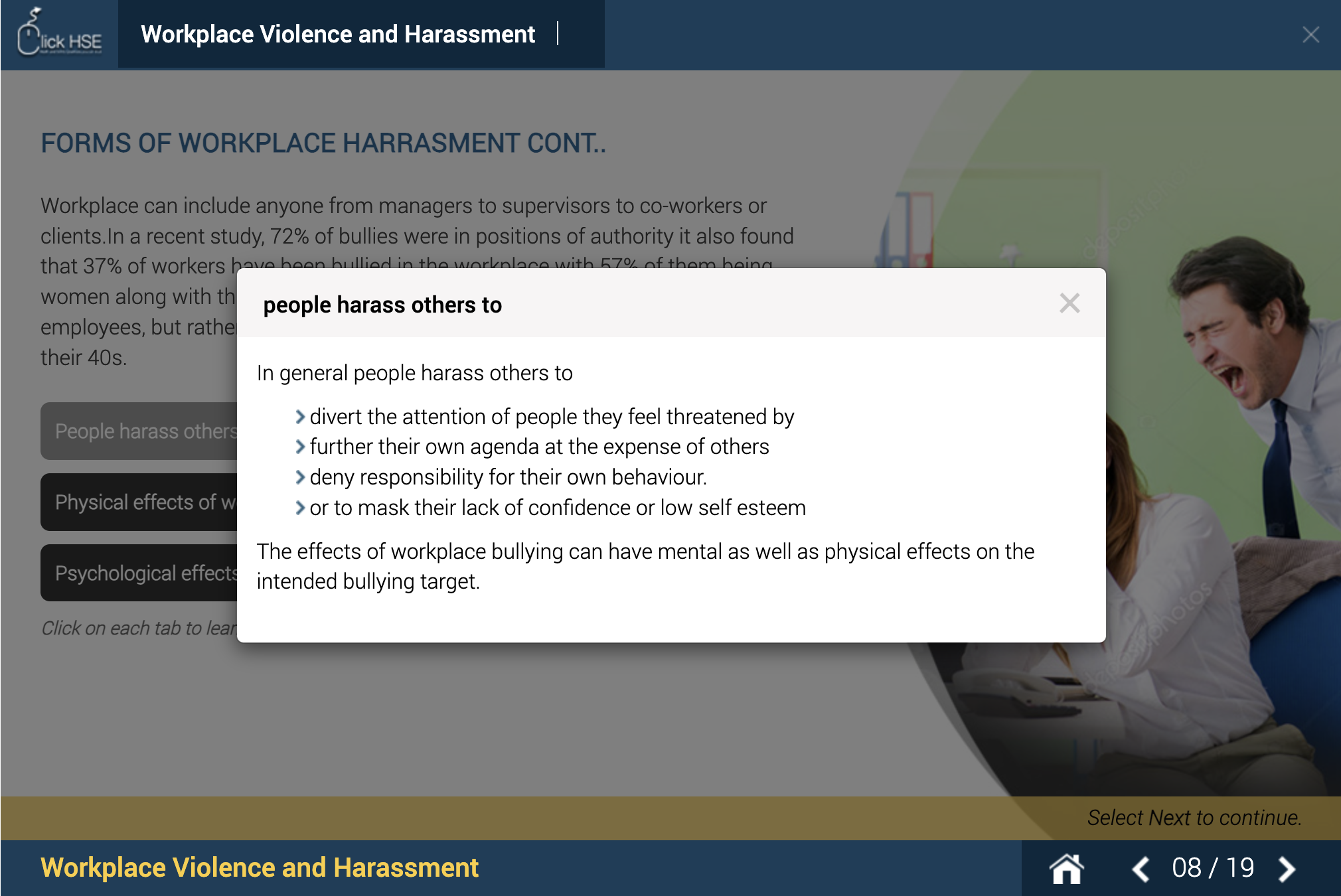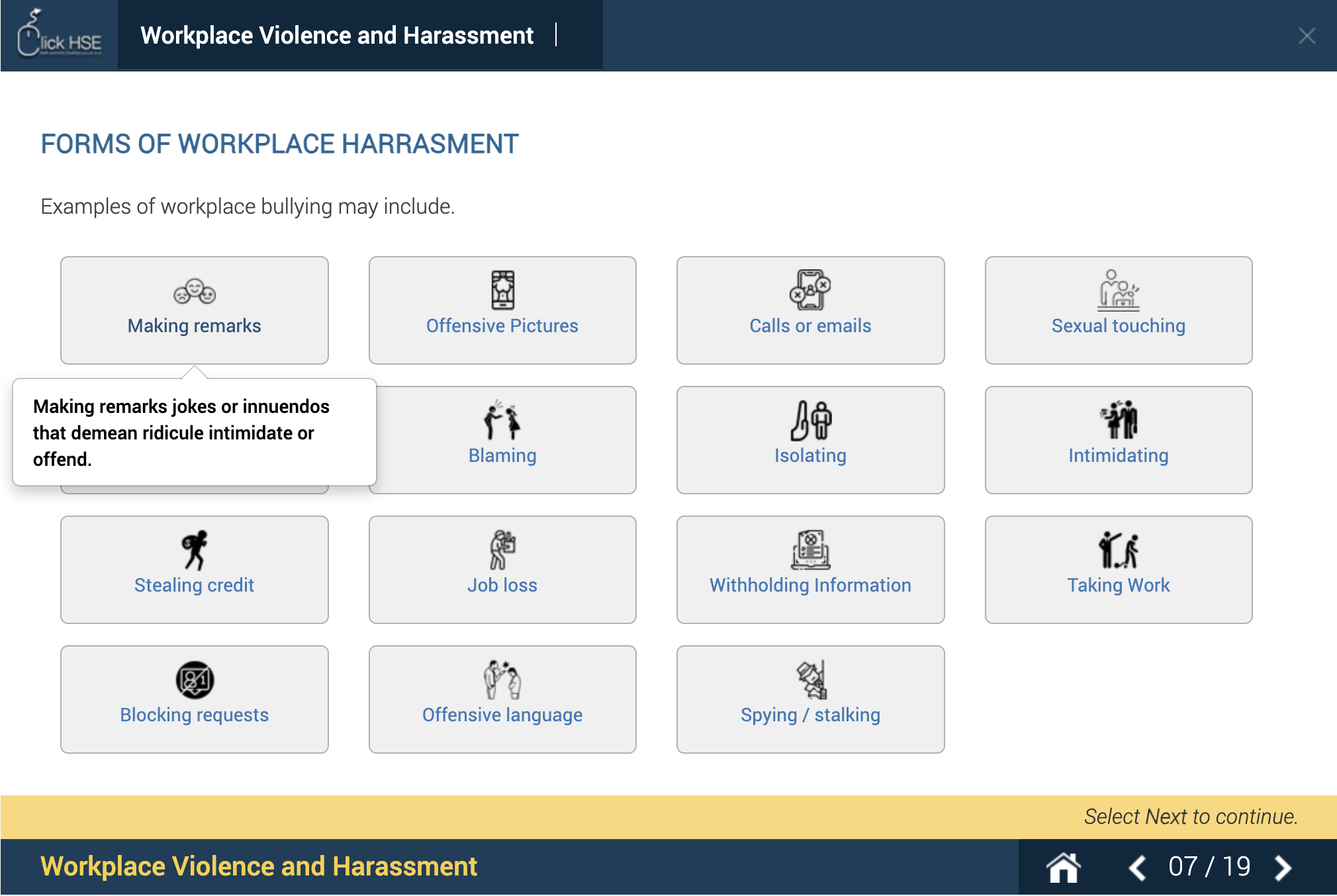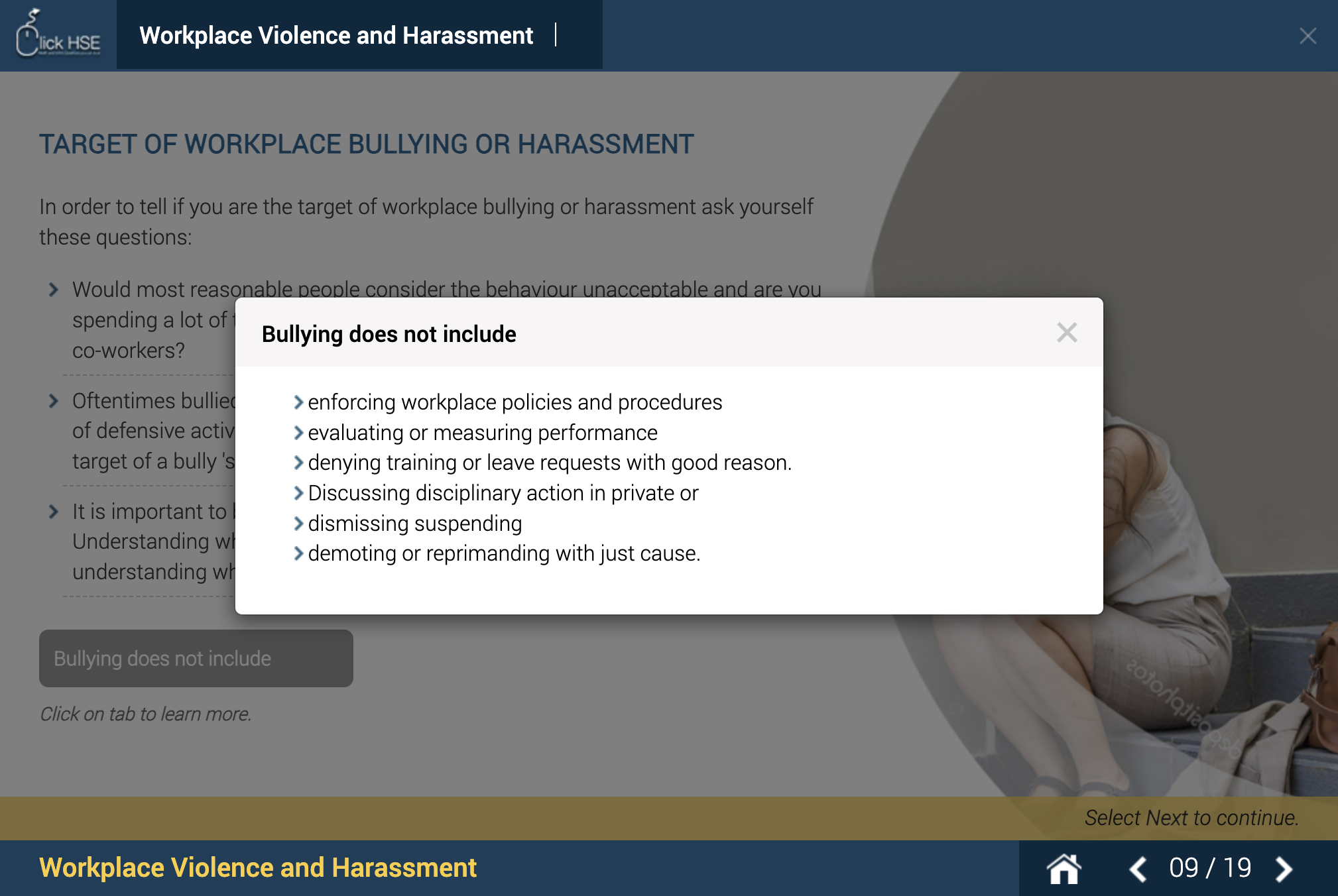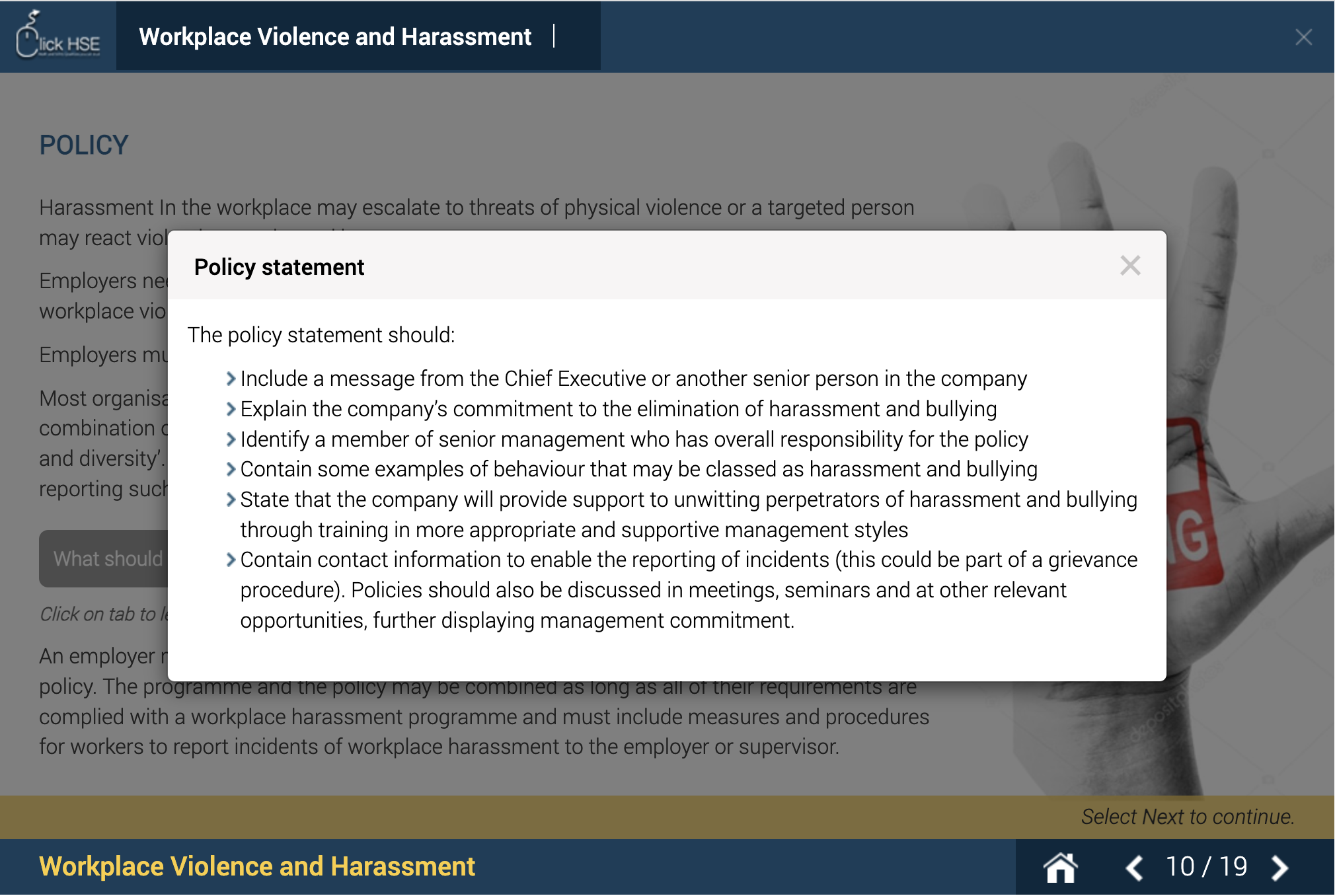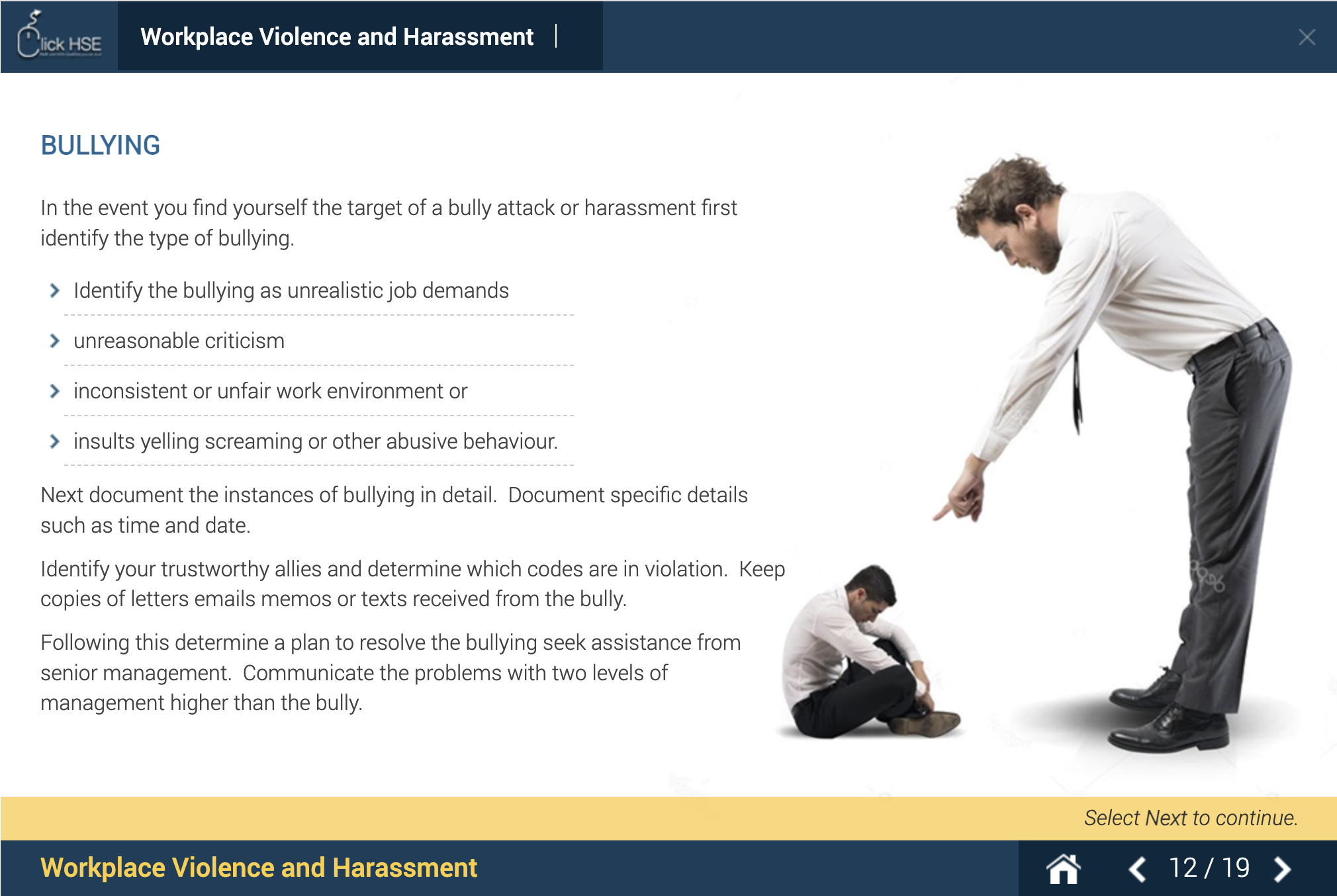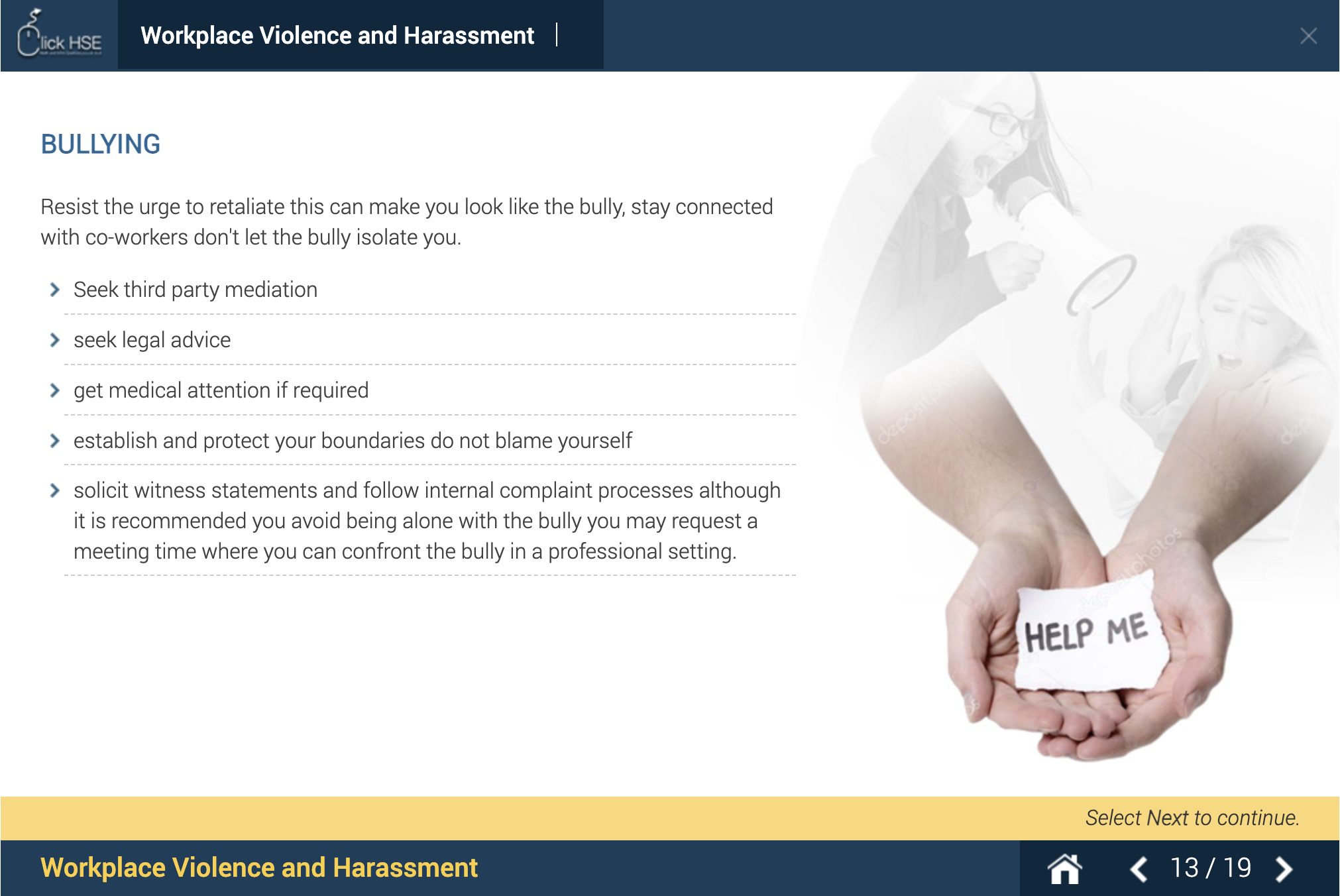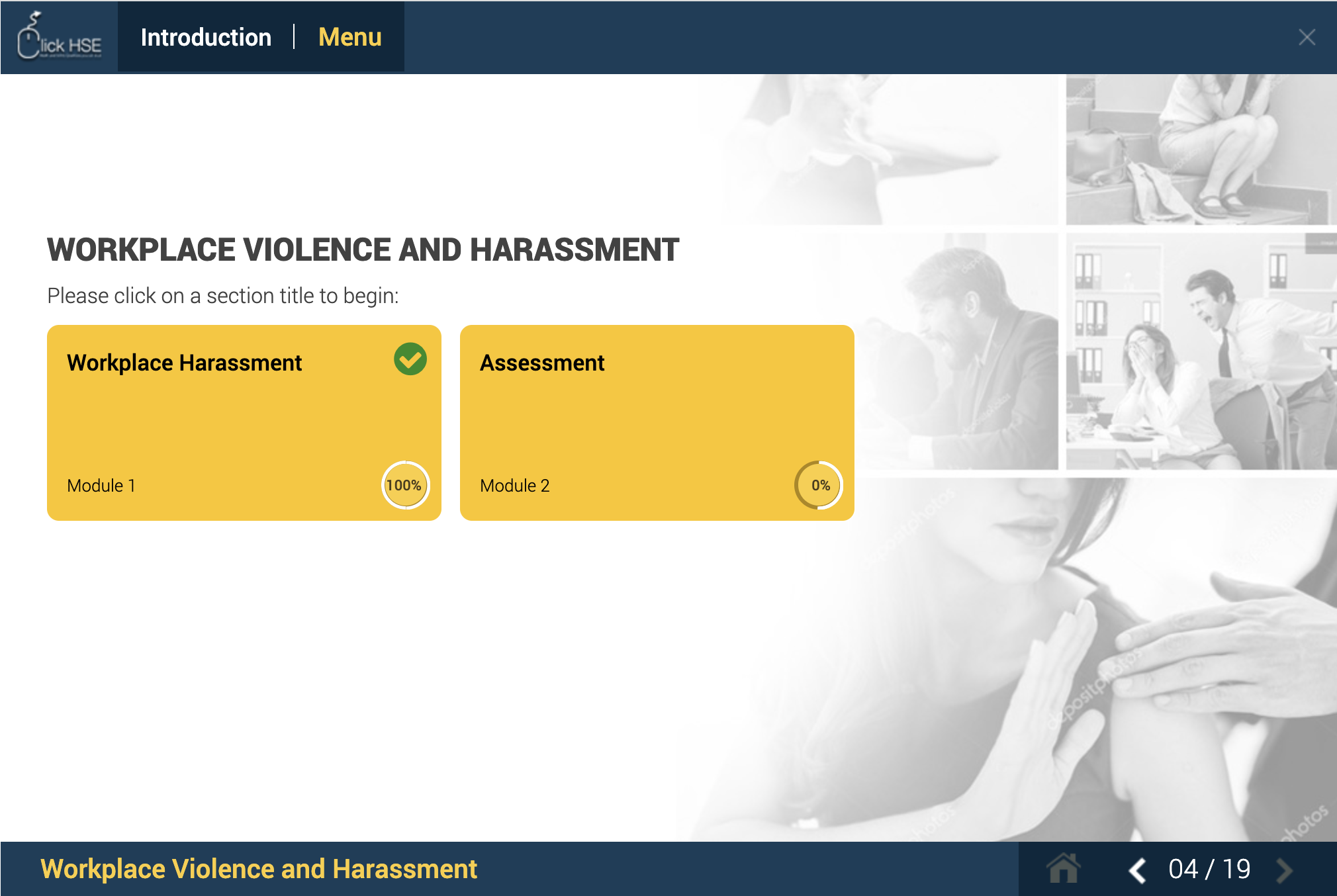Introduction to Workplace Bullying training
This online Workplace Bullying Training course helps develop knowledge of bullying and harassment as well as the pertinent laws that protect workers from harassment in any work environment, making it perfect for anybody in the workplace, including both employers and employees. All employees need to be aware of how severe bullying and harassment are and how they can affect someone's life.
Since companies have a responsibility to look out for their workers, it is crucial that they implement the proper safety precautions to help avoid bullying and harassment from occurring in the workplace.
📋 About this Workplace Bullying training course
This interactive course raises participants' awareness of workplace bullying and harassment and equips them with the skills and confidence they need to recognise, condemn, and stop inappropriate behaviour.
Bullying occurrences are often not reported because of lack of confidence, distrust, and fear of consequences.
This course's objectives are to increase student understanding of bullying and harassment, to consider the roles that each party may play, to explore ways to confront unacceptable behaviour, and to work towards a zero-tolerance policy for bullying at work.This course also features
🗣 Professional voiceover 📌 Bookmarking 🎓 Instant certification 💬 Assessment test feedback
Useful information
🏛️ Workplace Bullying training legislation
According to the Equality Act of 2010, bullying may also constitute harassment in certain circumstances. If it is, you have the right to take legal action.
You might be able to solve the issue in another way if the bullying does not qualify as harassment under the Equality Act.
When someone engages in any of the following: abusively spoken to you posted offensive posters, made offensive physical gestures or facial expressions towards you, asked you highly personal questions about, for instance, your disability or religion, and made comments on social media that you find offensive.
If the activity complies with the Equality Act's definition of harassment, even if your coworkers claim it was simply pleasant banter, it may still be considered harassment.
If the harassment is particularly severe, it might even be illegal. For instance, it is unlawful for someone to have sexually abused you or to have threatened you with harm. If you're afraid about your safety, call the police.
Check what's harassment under discrimination law
The behaviour you're complaining about had to be something you didn't want in order to qualify as harassment in any kind. 'Unwanted behaviour' is the legal term for this.
Additionally, you must always prove that the person who harassed you intended to do so or that you felt that way despite their lack of malice. 'Purpose or impact' is the term for this. It also needs to be'reasonable' that you felt that way if the other person didn't intend to make you feel that way.
You must demonstrate that the behaviour harmed your dignity or contributed to an atmosphere where:
insults you humiliates you injures you is unfriendly is demeaning
Additionally, you must demonstrate that one of the three categories of harassment defined by discrimination law applies to your situation.
The first type occurs when the inappropriate behaviour is connected to an applicable "protected characteristic," such as sex or race.
The second category is one in which the inappropriate behaviour is sexual in nature.
The third type is when you receive poorer treatment as a result of rejecting or complying with inappropriate sexual behaviours, gender- or sex-related behaviour, or both. This is referred to as "getting treated unfairly."
Whether the behaviour is aimed at you or not, for instance, it doesn't matter if you overhear your coworkers making racist jokes or remarks to one another.
The Equality Act of 2010's Section 26 addresses harassment.
Check if it's related to a 'protected characteristic'
You are protected by the Equality Act against harassment because of "protected characteristics" like your religion or a disability.
You should file a complaint under the harassment relating to your sex statute if the harassment is connected to maternity or pregnancy.
In accordance with Sections 5 through 12 of the Equality Act, protected qualities include:
Age
You are protected by the law from discrimination because of age.. young or old
in a certain age range, such as 15 to 18,
or under 60 of a certain age, such as 40-year-olds
Section 5 of the Equality Act of 2010 defines age.
Disability
Both current and past disabilities that you have overcome are covered. Even if you don't think of yourself as disabled, you may be covered if you have a physical or mental disability.
You should determine whether the Equality Act applies to your impairment.
The Equality Act of 2010's section 6 defines disability.
Gender reassignment
The term "gender reassignment" in the law refers to transgender people.
If any of the following are considering transitioning - you don't need to have had any medical care - are transitioning - or have already transitioned
Although the law is complex, if you identify as non-binary but aren't transitioning, you may be protected. Before moving forward, you must get professional counsel.
The Equality Act of 2010's section 7 defines gender reassignment.
Race
You are included in this:
Colour, such as whether you are black or white, and nationality
Your ethnic origin, such as if you are of Romany Gipsy descent, may not be the same as your nationality, such as if your family is Indian yet you hold a British passport.
If you're unsure of what race entails, you can read a more thorough explanation in Chapter 2 of the EHRC Code of Practise on Employment.
Section 9 of the Equality Act of 2010 defines race.
Religion or philosophy
This comprises:
adhering to a formal religion, such as Judaism; having a religious conviction, such as the requirement that you pray at specific times; not having a religion, such as atheism; or having philosophical convictions, such as pacifism.
Section 10 of the Equality Act of 2010 defines religion or belief.
Sex
This is whether you're a man or a woman.
If you identify as non-binary you might be covered but the law is complicated. You’ll need to get specialist advice before you go any further.
Sex is defined in section 11 of the Equality Act 2010.
🕒 Workplace Bullying course duration
The average seat time to complete this eLearning course in full is 45-60 minutes.
This provides a great solution for businesses of all sizes to provide adequate health and safety training without the downtime associated with third-party group training sessions.
🎓 Workplace Bullying certification
At the end of the course you will be presented with an assessment of multiple choice questions and on passing this test will be awarded the course certificate.
On completion of the course each trainee will be awarded a fully personalised certificate which can be printed or downloaded directly after course completion.
For businesses, each employee certificate is automatically saved within our secure learning management system alongside the users test results for ease of reference.
🏆 CPD accreditation
This Workplace Bullying eLearning course is a fully CPD accredited and provides 1 hour credit per person for your Continuing Professional Development records.
Continuing Professional Development (CPD) elearning accreditation is an important tool for enabling professionals to keep their skills and qualifications up-to-date. It is a process of assessing, monitoring, and validating training courses or learning activities that help people to maintain their professional knowledge and expertise. CPD has become increasingly popular in recent years with many organisations encouraging it as part of their commitment to professional development.
CPD elearning accreditation ensures that the material being studied meets both quality and relevancy standards. It also provides an assurance that the course content is relevant to current industry practices and trends as well as up-to-date with new scientific discoveries and regulations. This ensures that learners have access to the most current information available when completing a course of study.
CPD elearning accreditation is an important tool for helping professionals stay at the forefront of their field by ensuring they have access to the highest quality education possible. It also helps organisations better manage their learning resources, giving them more confidence that they are providing their employees with relevant and up-to-date material for professional development purposes.
🔌 SCORM 1.2 LMS plugin
For businesses with an existing learning management system (LMS) this course is available as an off-the-shelf eLearning plugin in the commonly used SCORM 1.2 format.
Elearning courses that can be plugged into an LMS via SCORM 1.2 provide a great way to deliver engaging and interactive educational content to a wide variety of online learners. SCORM (Sharable Content Object Reference Model) is the most widely adopted e-learning standard for creating, delivering, and tracking online learning content.
With SCORM 1.2, an LMS can integrate our professional training content, allowing you to easily add workplace bullying training to your internal course portfolio to complete your training matrix.
By utilizing our workplace bullying eLearning course plugin, learning and development teams are able to facilitate training across employees while at the same time track their progress accurately and effectively to measure success outcomes within your own LMS.
⚙️ How Workplace Bullying elearning works
Once your ClickHSE learning account is created you will be sent a welcome email with a secure link to create your password and access your online Workplace Bullying training. You can login from ant modern device connected to the internet securely to our award-winning online health and safety learning management system.
You can complete the course at any time or location to suit you and use the built-in bookmarks to return to your position within the course should you need to take a break.
The course is broken up into various chapters and follows our established learning workflow, taking each trainee from basic topic introduction through to developing a wider understanding around the use of display screen equipment.
At the end of the course you will be presented with an assessment of multiple choice questions and will need to score 80% to be awarded the course certificate. Feedback is provided at the end of each assessment helping learners to understand any incorrect answers made. Trainees can retake the course or assessment as many times as are needed during the lifetime of the course subscription.
👤ClickHSE Individual (1-9 users)
For individuals wishing to complete this course or small groups of up to 9 users ClickHSE Individual grants 60 days access form the date of initial assignment to complete the course with unlimited retakes during this period.
💼 ClickHSE Business (10-499 users)
For businesses and organisations with groups of 10-499 users being required to complete this course ClickHSE Business provides you with our free-to-use learning management system. Intuitive and eesy to use for both staff and managers alike ClickHSE Business comes complete with easy staff onboarding, instant reports, certificate tracking and 12 months access to your courses.
🏢 ClickHSE Enterprise (500+ users)
For businesses and organisations with 500+ users we provide you with ClickHSE Enterprise, giving you access to a wide range of powerful management, reporting and automation tools. Instantly deploy training across multiple locations and departments, track team progress and manage refresher training in just a few clicks. Alternatively this accredited DSe course can be provided as a SCORM 1.2 plugin for your existing in-house learning management system.
🖥 Course content
The Workplace Bullying training course helps users to understand the importance of workplace bullying, how to recognise it, deal with it and report it within the workplace.
Sections of the module cover examples of bullying as well as showing how to conduct yourself if faced with bullying or harassment within the workplace.
📒 Key workplace bullying training course topics include
Introduction
What is bullying
Laws that are relevant
The possible repercussions of bullying in the workplace
The distinction between management and bullying
How important policies are, procedures to follow
Effective ways to stop bullying
How to respond to allegations of bullying
Assessment test paper
🎬 Workplace Bullying training course demo
If you are a business user looking to provide Workplace Bullying training for 100+ personnel we are pleased to provide you with demo access to the full version of this course.
📊 Pricing for Workplace Bullying training
We believe in transparent pricing with no hidden costs and provide upfront and affordable tiers for Workplace Bullying training to help you order easily:
Train 1-9 people £19.95 each
Train 10+ people £13.50 each
Train 25+ people £7.95 each
Train 50+ people £6.25 each
Train 75+ people £5.50 each
Train 100 people £4.95 each
Training 100+ people? Contact us for special rates
🔆 Order today and get intant access
Want to mix with other courses?
View bulk discounts for team training →
📓 Workplace Bullying Faqs
-
Employers are responsible for preventing bullying and harassment - they’re liable for any harassment suffered by their employees.
-
Bullying and harassment is behaviour that makes someone feel intimidated or offended. Harassment is unlawful under the Equality Act 2010.
-
Bullying itself is not against the law, but harassment is. This is when the unwanted behaviour is related to one of the following:
-
No, Bullying and harassment can happen:
face-to-face
by letter
by email
by phone
-
Examples of bullying or harassing behaviour include:
spreading malicious rumours
unfair treatment
picking on or regularly undermining someone
denying someone’s training or promotion opportunities
-
Employees should see if they can sort out the problem informally first. If they cannot, they should talk to their:
manager
human resources (HR) department
trade union representative

